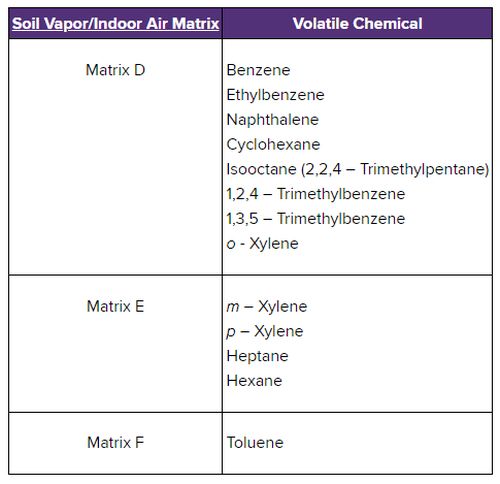Highlights
- The New York State Department of Health (NYSDOH) announced an update to its Guidance for Evaluating Soil Vapor Intrusion in the State of New York, which now includes three new categories (matrices) for petroleum-related air contaminants.
- For the first time, the three new matrices include 13 volatile organic compounds (VOCs) related to petroleum products, including benzene, toluene, ethylbenzene and xylene (BTEX).
- Entities monitoring soil vapor concentrations under state contaminated site remediation programs will now be required to sample for these petroleum-related VOCs.
- Real estate owners, developers and investors may be required to take mitigation measures depending on sub-slab vapor or indoor air concentrations for these newly added airborne contaminants.
The New York State Department of Health (NYSDOH) in late February 2024 announced an update to its Guidance for Evaluating Soil Vapor Intrusion in the State of New York. For the first time, the Soil Vapor/Indoor Air Decision Matrices (SV/IA Matrices) include petroleum-related volatile organic compounds (VOCs). This development by NYSDOH, grounded in a comprehensive review of toxicity data, risk assessments and soil vapor intrusion (SVI) data, led to the inclusion of 13 petroleum VOCs across three newly established matrices – D, E and F:

Source: NYSDOH Website
Although the SV/IA Matrices are nonbinding guidance documents, these updates are likely to have far-reaching implications, particularly for real estate developers and investors who encounter properties impacted by former petroleum usage such as old gasoline service stations, automobile repair shops and sites with abandoned petroleum-holding underground storage tanks (USTs). Further, compliance with the matrices may be required for sites involved in certain state regulatory programs.
Understanding the Updated SV/IA Matrices
The SV/IA Matrices serve as a crucial tool to assist environmental regulators, engineers, consultants, attorneys and other professionals in evaluating the potential health risks posed by VOCs found in soil vapor and indoor air. When properly applied, the matrices allow professionals to assess whether further action – such as additional sampling or continued monitoring – may be warranted. Specifically, in some instances, NYSDOH recommends no further action. However, when soil vapor and/or indoor air concentrations appear to be elevated, NYSDOH recommends additional sampling, regular monitoring or even implementation of mitigation measures (e.g., sealing air pathways, installation of a sub-slab depressurization system, etc.). For example, see Matrix E for xylenes, heptane and hexane below:

Source: NYSDOH, SV/IA Matrices
Legal and Regulatory Implications
These updates to the SV/IA Matrices will impact stakeholders involved in the development and/or management of contaminated sites. The nuanced framework introduced by the updated matrices necessitates a reevaluation of legal strategies in several key areas:
- Enhanced Due Diligence: Developers of properties with former petroleum-dependent operations (e.g., gasoline service stations, automobile repair shops, junkyards, etc.), heavy UST use or those enrolled in any of the various state regulatory programs for contaminated sites (e.g., Inactive Hazardous Waste Disposal Site Program, Brownfield Cleanup Program, etc.) may be required to conduct additional due diligence to include sampling and lab analysis for these petroleum VOCs.
- Enhanced Tenant and Occupant Notices. Landlords with properties enrolled in several state regulatory programs for contaminated sites already have an obligation to provide indoor air sampling results to tenants and occupants pursuant to Article 27 of the Environmental Conservation Law (ECL 27-2405). For instance, parties subject to an order under the State Superfund or Oil Spill programs, or a participant enrolled in the Brownfield Cleanup Program must provide tenants and occupants with results of indoor air tests that exceed either NYSDOH guideline(s) or Occupational Safety and Health Administration (OSHA) guideline(s) for indoor air quality. With the addition of petroleum-related VOCs to the SV/IA Matrices, landlords and property managers must be vigilant to ensure they are complying with these notification requirements.
- Liability and Remediation: The addition of these petroleum-based VOCs to the SV/IA Matrices may influence liability for contamination, particularly in circumstances where owners decide to ignore NYSDOH recommendations for enhanced monitoring or mitigation, or where sampling suggests offsite impacts. In addition, identification of elevated soil vapor and/or indoor air concentrations may trigger obligations to conduct further environmental investigations or implement required cleanup or mitigation under applicable federal or state laws.
- Regulatory Compliance and Stakeholder Engagement: Certain projects will require adherence to the updated matrices before securing governmental approvals and fostering positive relations with stakeholders, including regulatory agencies and local communities. For example, properties subject to soil vapor intrusion investigation requirements under the Brownfield Cleanup or Superfund programs must conduct sampling and follow NYSDOH requirements under the SV/IA Matrices. In practice, this means the New York State Department of Environmental Conservation (NYSDEC) will not approve remedial work plans that fail to follow NYSDOH guidelines for indoor air contamination.
- Insurance and Financial Planning: Developers and investors may need to reassess their environmental risk profiles and explore more robust management tools, including environmental insurance, to account for potential increased costs associated with detections of petroleum-based VOCs in indoor air or sub-slab soil vapor.
Conclusion
The updates to the SV/IA Matrices represent a significant milestone since they include, for the first time, petroleum-related compounds. For brownfield redevelopers and investors, these updates call for a comprehensive approach to project planning and environmental compliance, including an updated evaluation of the potential legal implications associated with petroleum-contaminated sites.
Collaboration with experienced environmental attorneys and consultants will be crucial in addressing the complexities of SVI risks and leveraging these updates to achieve successful, sustainable redevelopment outcomes. Moving forward, the commitment to rigorous environmental stewardship, informed by the latest scientific and legal developments, will play a pivotal role in transforming contaminated sites into vibrant, healthy communities.
The content of this article is intended to provide a general guide to the subject matter. Specialist advice should be sought about your specific circumstances.


